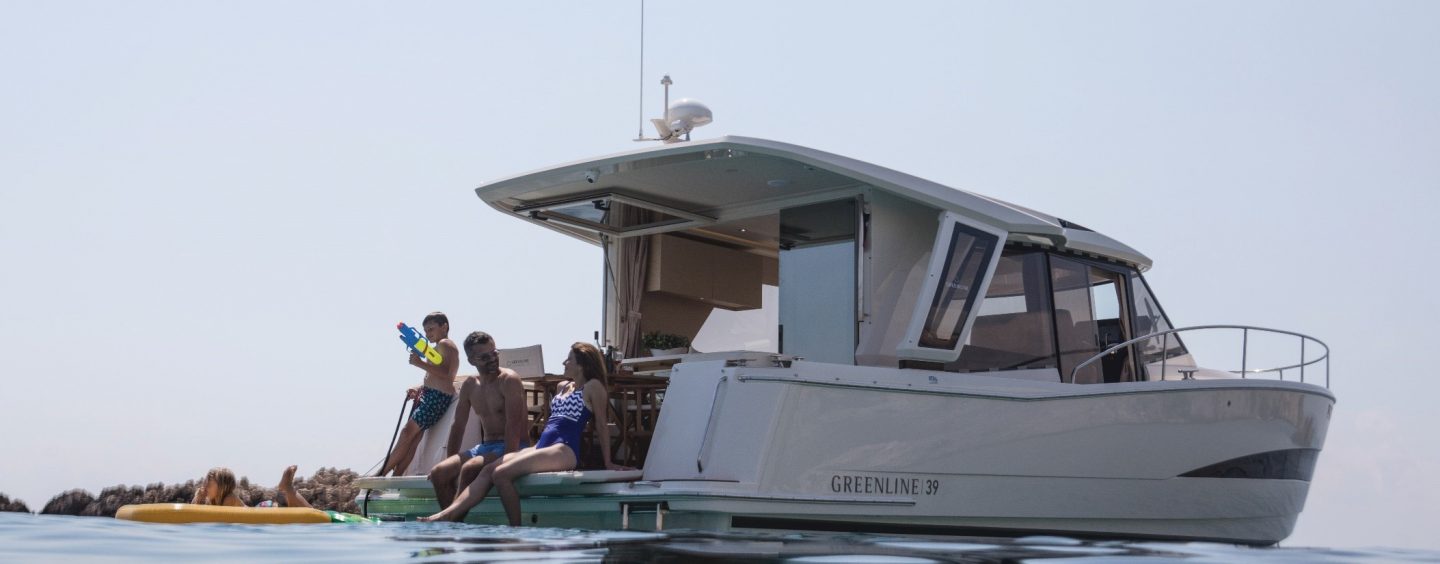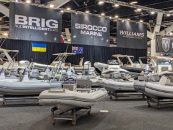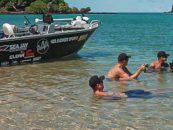SUSTAINABLE BOATING POWER OF THE SUN
Eyachts have always prided themselves in being early adopters of new ideas. When they added Greenline to their portfolio in 2012, this was the first-ever hybrid production boat company in the world. At the time, the concept was still relatively foreign, especially to the boating world, but now, in 2021, Australia and the world have certainly warmed to the idea.
This push from the public was visible at the 2021 Sanctuary Cove International Boat Show (SCIBS) where prospects flocked to the Greenline 39 to find out more about the hybrid system and what Greenline, in particular, has to offer. It is not just hybrid and electric propulsion that Greenline offers to the sustainable boating space, it is also the standard solar and battery system that allows owners to operate their vessel predominantly using the power of the sun.
Greenline invested an enormous amount of time, effort, engineering expertise and funding to produce their state-of-the-art, revolutionary low-drag hull, which was constructed using advanced fusion technology to achieve significant savings in weight. These innovations in design and materials enable optimal performance when using the electric motor and lower running costs when operating under diesel power.
Greenline offers the option of either conventional, hybrid, or electric drives. Given the interest in the 12-metre Greenline 39 hybrid in Australia, we will discuss its operation further here.
The hybrid version involves a combination of a diesel engine (either a strong, reliable 220HP Volvo Penta D3 with a long service life, or a 370HP Yanmar V8 with the best power-to-weight ratio in its class) and a powerful electric motor/generator. The electric motor/generator is mounted in line with a specifically developed gearbox, with a hydraulic clutch between it and the diesel engine. A high-tensile stainless-steel drive shaft is turned to drive the propeller.
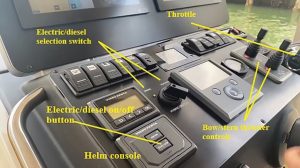 Changing the mode of operation between electric and diesel is made at the helm console. Suppose you have been cruising using the diesel engine and are about to enter a quiet marina. You would throttle back to neutral, stop the diesel engine by pressing a button, turn the hybrid switch to electric, which disengages the diesel via the clutch, press the button to start the electric motor, and using the same throttle, increase speed. Finished with electric? Throttle back to neutral, turn the hybrid selector switch to diesel, which engages the clutch, then press the starter button. Simple.
Changing the mode of operation between electric and diesel is made at the helm console. Suppose you have been cruising using the diesel engine and are about to enter a quiet marina. You would throttle back to neutral, stop the diesel engine by pressing a button, turn the hybrid switch to electric, which disengages the diesel via the clutch, press the button to start the electric motor, and using the same throttle, increase speed. Finished with electric? Throttle back to neutral, turn the hybrid selector switch to diesel, which engages the clutch, then press the starter button. Simple.
Electric bow and stern thrusters are available for docking and manoeuvring.
To assist you with monitoring the electrics, there is a display screen on the console which will provide details of electrical charge available, charging rate, running time remaining, and so on.
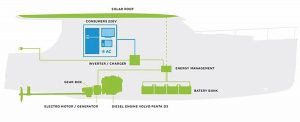 Using diesel power, the Greenline 39 can reach up to 18 knots (Volvo Penta) or 25 knots (Yanmar), and can cruise at around 7 knots for 1000 nm using a 700L tank of diesel fuel.
Using diesel power, the Greenline 39 can reach up to 18 knots (Volvo Penta) or 25 knots (Yanmar), and can cruise at around 7 knots for 1000 nm using a 700L tank of diesel fuel.
With the electric motor, it is possible to cruise at around 4 knots for 20nm on battery power, which should be enough for a relaxed day trip. All dependent on conditions, of course.
The lithium-polymer battery bank, with around one-seventh of the weight and one-third the size of an equivalent capacity lead-acid battery array, can be recharged using DC electricity in three ways, controlled by the energy management system:
> During daylight hours, whether at anchor or underway, the solar panel roof array will continually produce DC electricity, which is directed to the battery bank through the energy management system.
> When using the diesel engine, the electric motor becomes a 10kW generator, which provides DC electricity to the battery bank through the energy management system. Full charge can be achieved in about two hours.
> If connected to AC mains power (say, at a marina), the electricity is converted to DC by an inverter/charger, then conducted to the battery bank via the system.
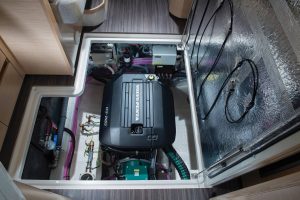 Similarly, the energy management system controls DC electricity flowing out of the battery bank:
Similarly, the energy management system controls DC electricity flowing out of the battery bank:
> DC electricity from the batteries powers the motor when operating in electric mode.
> DC electricity is drawn from the batteries, passed through the inverter/charger to convert it to 230V AC, and used to run the various onboard appliances, including the 224L refrigerator with freezer, induction stove, electric oven/microwave, television, and air conditioner.
The lithium-polymer batteries are capable of thousands of recharge cycles and have a life-expectancy of ten years.
Under electric motor power, your boat will move serenely through the water. Apart from virtually no noise but the gentle swishing of water, there is no vibration and no fumes – zero emissions. This is an ideal mode for entering and leaving marinas, cruising quiet waterways, or navigating residential canals. And – with a fully electronically managed and maintenance-free electric motor/generator – all for almost zero cost.
Your hybrid Greenline 39 will significantly reduce running costs and require fewer refuelling stops, giving you and your family more time to spend anchored at favourite places or just cruising.
Loyal Eyachts customer for the past six years, Ian Radford, a two-time Greenline owner who moved to the Greenline 39 in late 2019, had this to say: “We upgraded our Greenline 33 to a Greenline 39. The 39 builds on the 33’s open, liveable, practical, modern attributes and adds more space, functionality, and sea-friendliness. The helm door and the thrusters (bow and stern) make the 39 so much easier to use.”
Ian likes the larger displacement, which helps make the 39 much more sea-friendly in messy conditions. The yacht has twin stabiliser fins to enhance roll and tracking stability, and provide protection for the drive and rudder.
“Peter Hrones again showed that he is a true gentleman, and his company, Eyachts, reflects this approach to business,” said Ian.
Published in print October-December 2021






















